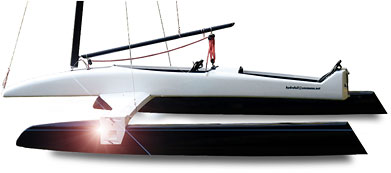Press
& News
February 2012 Pressrelease
- The
next generation: sailing on hydrofoils | PDF
Download (in german)
_____________________________________________________________________________________________________________________

Download Picture (300dpi)
|
Sailing really fast requires
- Lightweight construction throughout
All components of the
hydrofoil F1 are German-made, using epoxy-resin
carbon fibre, according to the newest lightweight manufacturing techniques
- Coupled with the highest rigidity
- A high righting moment
By setting the windward hydrofoil at a negative incidence, a huge
righting moment is generated. Only by doing this is it possible to
sail at high speed.
- Low drag force due to the water
The hydrofoils and the keels are made to dramatically reduce the
drag force of the water.
- On top of that, low aerodynamic drag
The sail, the cockpit and the hulls were painstakingly designed to
minimise aerodynamic drag. Not only does this work really well, it
also looks great.
|
The future
is above water, and this means sailing on hydrofoils
The hydrofoil
F1 is a
- Lightweight catamaran which is fast and easy
to sail
- Even a light wind is enough to get moving
- Above 3 on the Beaufort scale, it's currently
the fastest sailboat on the market
- For all points of sail !
- Quick assembly in several minutes
- Can easily be sailed by 1 or 2 people - Dry and
comfortable sailing due to the ergonomically designed cockpit
|
|
- Technical data hydrofoil
F1 )*
Hydrofoil catamaran sailboat for 1 or 2 people, built using epoxy-resin
carbon fibre materials (prototype is described here)
- Length 18 ft. / 5.5 m
- Width (when beaching) 12 ft. / 3.5 m
(foilborne) 16 ft. / 5.0 m
- Sail area 150 sq.ft. / 14.0 m²
- Weight 306 lbs / 138,4 kg
- Speed approx. 42.2 kts / 75,6 km/h
|
Our
catamaran takes off...
We're
accepting orders starting May 2012.
Pricing available on request.
Engineering and design
Klaus
J. Enzmann
hydrofoil@enzmann.net
Biography
K. Enzmann
Software
Christian
Enzmann, Munich
ce@enzmann.net
Realisation
Catlift GmbH & Co. Entwicklungs KG
82152 Planegg, Germany
We are looking for licencees and sales agents worldwide.
Please contact us if you are interested. |
_____________________________________________________________________________________________________________________
The
right concept at the right time
Flying over the surface of the water is an experience
you'll never forget. The hissing and spraying of the hull and the annoying motion
of the waves disappear within seconds, changing into a quiet whooshing sound,
accompanied by a noticeable increase in speed. It's easy to become addicted!
Why
use hydrofoils?
In 1962 in England, a catamaran using hydrofoils sailed for the first time on
the surface of the water, but not for long.
Without any type of control over the hydrofoils, the effort was doomed to fail.
Sailing on hydrofoils with just the help of the wind is quite spectacular, but
definitely not easy.
Worldwide, more and more sailors, especially those sailing catamarans, are turning
to hydrofoil technology. It's worth mentioning the success of the international
"Moth" Class, the first regatta category to sail on hydrofoils, as well as the
spectacular world speed record of 100 km/h set by the French "Hydroptère" in
2011.
The real challenge is to be able to control the "altitude" i.e. distance of
the boat above the water, regardless of the conditions. This distance should
always be the same: when the wind suddenly gusts and dies down again, when high
side forces are acting whilst beating, when the boat pitches whilst running
- all of that, no matter how rough the waves are.
*) World Pat. pend. Reg. Design
© Catlift
GmbH & Co. Entwicklungs KG 2012 - Alle Rechte vorbehalten.
Impressum.




